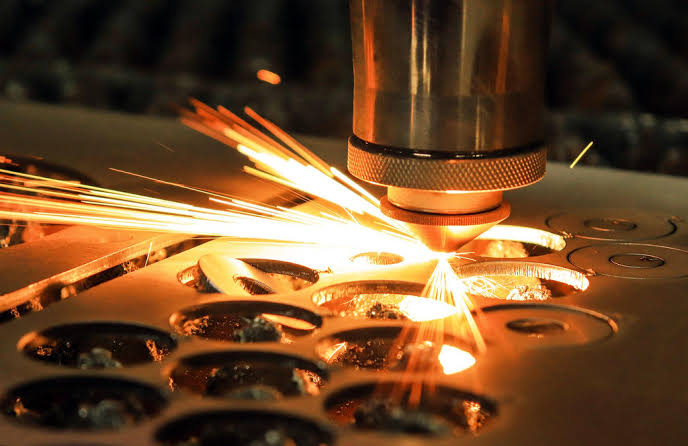In the rapidly evolving world of manufacturing, there’s one technology that’s light years ahead—laser processing. This article sheds light on the innovations shaping the future of manufacturing through laser technology. If you’re a manufacturing engineer, technology enthusiast, or an innovator curious about how lasers are revolutionizing industries, this piece is for you.
Introduction to Laser Processing Defining the Basics
Laser processing involves using focused light beams to cut, weld, mark, or alter materials with unprecedented precision. It’s a versatile technology that has been instrumental in advancing manufacturing processes across various sectors. The laser—a concentrated beam of photons—offers a unique ability to focus energy on minute areas, making it ideal for high-precision tasks. Whether it’s cutting through metals or engraving intricate designs, lasers have made cumbersome tasks seamless.
The significance of laser processing lies in its ability to enhance accuracy and efficiency while reducing waste. This technology has become a staple in industries where precision is paramount. Manufacturing engineers rely heavily on lasers for their ability to execute complex tasks with minimal human intervention, thus reducing errors and increasing productivity.
Understanding laser processing is crucial for anyone involved in manufacturing. As industries push towards automation, knowing how to leverage laser technology can give companies a competitive edge. This guide will illuminate the various aspects of laser processing, its evolution, and its impact on different sectors.
The Evolution of Laser Technology in Manufacturing
Laser technology has come a long way since its inception in the 1960s. Initially, lasers were primarily used in scientific research. It wasn’t until later that their potential in manufacturing was realized. Early applications included basic cutting and welding tasks, but technological advancements soon expanded their capabilities.
Over the decades, lasers have evolved to offer higher power outputs and more precise control over the beam, allowing for more applications. The integration of computer numerical control (CNC) has further enhanced the precision and repeatability of laser-based processes. These innovations have enabled lasers to perform tasks that were once considered impossible.
Today, laser technology is central to advanced manufacturing processes. Its evolution has been fueled by the demand for higher quality standards and increased efficiency in production lines. The continuous refinement of laser technology promises even greater capabilities in the near future, enabling manufacturers to push the boundaries of what’s possible.
Innovations in Laser Processing Solutions
Precision Techniques for Modern Fabrication
High-precision laser cutting and welding equipment have revolutionized the way manufacturers approach material joining and separation. Lasers provide unparalleled accuracy, allowing for clean cuts and strong welds without altering the material’s properties. This precision is particularly beneficial in industries such as aerospace and automotive, where safety and durability are critical.
Laser cutting offers flexibility in handling a wide range of materials, from metals to polymers. The ability to focus on small areas reduces thermal distortion, preserving the integrity of the material. Additionally, laser welding ensures strong, defect-free joints, which are essential in high-stress applications.
Manufacturers benefit from lasers’ ability to automate cutting and welding processes, reducing labor costs and minimizing waste. This not only enhances productivity but also ensures consistent quality, which is vital for maintaining competitive advantage in global markets.
Laser Marking and Engraving Advances
Laser marking and engraving have seen significant advancements, offering manufacturers new ways to enhance product aesthetics and functionality. This technology allows for permanent markings that can withstand harsh environmental conditions. Whether it’s serial numbers, barcodes, or logos, laser marking provides a durable solution.
The precision of laser engraving allows for intricate designs that can add aesthetic value to products. This is particularly useful in consumer electronics and luxury goods, where appearance plays a crucial role in consumer choice. With advancements in laser technology, markings can be produced faster and with greater detail than traditional methods.
One of the key benefits of laser marking is its non-contact nature, which prevents damage to the product surface. This makes it ideal for use on delicate materials where traditional marking methods could cause harm. The versatility and efficiency of laser marking are making it indispensable in modern manufacturing.
3D Printing with Laser Technology
3D printing has become a game-changer in manufacturing, and lasers are at the heart of this transformation. Laser-based 3D printing, or additive manufacturing, allows for the creation of complex geometries that were once thought impossible. By building objects layer by layer, manufacturers can produce parts with reduced material waste and shorter lead times.
Lasers offer the precision required to manipulate materials at a microscopic level, which is crucial for creating detailed components. This technology is invaluable in industries such as medical devices, where customized implants and prosthetics can be produced to patient-specific dimensions.
The ability to rapidly prototype with laser 3D printing accelerates innovation, enabling manufacturers to test and refine designs quickly. This reduces time-to-market for new products, providing a significant competitive advantage in fast-paced industries.
Emerging Trends in Laser Processing
The field of laser processing is continuously evolving, with emerging trends that promise to reshape the landscape of manufacturing. One such trend is the development of ultrafast lasers, capable of performing tasks with incredible speed and precision. These lasers enable manufacturers to process materials that were previously challenging, opening up new possibilities for innovation.
Another trend is the integration of artificial intelligence (AI) in laser processing systems. AI enhances the precision and efficiency of laser operations by optimizing parameters in real-time. This leads to improved quality control and reduced waste, making processes more sustainable.
Sustainability is also driving innovations in laser processing. Manufacturers are increasingly looking for eco-friendly solutions, and lasers offer a clean alternative to traditional methods. The trend towards greener manufacturing practices is likely to accelerate the adoption of laser technology.
The Impact on Various Industries
Automotive
In the automotive industry, lasers are used extensively for cutting, welding, and engraving components. The precision of laser technology ensures that parts meet stringent safety standards, while its efficiency reduces production costs. Lasers also enable the lightweighting of vehicles, contributing to better fuel efficiency.
Aerospace
Laser technology is critical in aerospace manufacturing, where the demand for precision and reliability is paramount. Lasers are used to produce components that withstand extreme conditions, ensuring the safety and performance of aircraft. The ability to create lightweight structures with lasers also contributes to fuel savings.
Medical
The medical industry benefits from laser processing in the production of implants, surgical instruments, and diagnostic equipment. The precision of lasers allows for the creation of highly detailed and customized components. This is particularly important in personalized medicine, where patient-specific solutions are required.
Consumer Electronics
In consumer electronics, lasers play a vital role in producing intricate components and enhancing product aesthetics. From engraving logos to cutting circuit boards, laser technology provides the precision and efficiency needed to meet consumer demands. The ability to quickly adapt to design changes is a significant advantage in this fast-paced industry.
The Future of Laser Technology Predictions and Insights
The future of laser technology in manufacturing is bright, with numerous opportunities for growth and innovation. As ultrafast lasers become more prevalent, manufacturers will be able to achieve unprecedented levels of precision and speed. This will open up new applications and enable the production of increasingly complex components.
The integration of AI in laser processing systems will further enhance efficiency and quality control. Manufacturers will benefit from real-time optimization and predictive maintenance, reducing downtime and costs. This will make laser technology even more attractive to industries looking to boost their competitiveness.
Sustainability will continue to be a driving force in the evolution of laser processing. Manufacturers will seek out lasers as a cleaner, more efficient alternative to traditional methods. This will lead to broader adoption across industries and contribute to more sustainable manufacturing practices.
Conclusion
Now that we have explored the basics of laser processing and its applications in various industries, it is clear that this technology has revolutionized manufacturing. With its precision, speed, and flexibility, lasers offer a wide range of benefits that are essential for staying competitive in today’s market.








